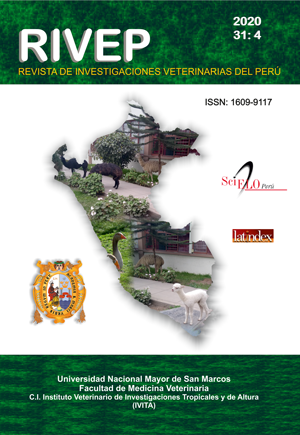Metabolizable energy requirements for maintenance and live weight gain of llamas and alpacas determined by the comparative slaughter technique
DOI:
https://doi.org/10.15381/rivep.v31i4.16738Keywords:
alpaca, emergy, llama, requirements, comparative slaughterAbstract
The aim of this study was to determine the metabolizable energy requirements for maintenance (MEm) and growth (MEg) of llamas and alpacas, by the comparative slaughter technique, at 4200 m above sea level. Twenty male llamas (106.6 ± 7.7 kg live weight, LW) and 20 male alpacas (55.7 ± 4.9 kg LW), both of two years of age, were subdivided into 5 groups of 4 animals each, per species. One group was slaughtered at the beginning of the study to measure the initial body energy content, and the remaining four groups were fed over a period of 55 days on a mixture of chopped hay of oats and Lucerne at four levels of feed (94.2% dry matter, DM): maintenance, intermediate low, intermediate high and ad libitum; corresponding to 40, 50, 60 and 70 g DM/kg LW0.75, respectively. All animals were slaughtered at the end of the experiment to determine retained energy (RE). Another group of four animals per species were used in a parallel in vivo metabolism study to determine the metabolizable energy (ME) content of the diet. Samples of the diet, faeces, and the animal body, were analysed for gross energy contents. The ME content of the diet did not differ between levels if feeding or species, 2226 ± 206 and 2212 ± 165 kcal/kg DM for llamas and alpacas, respectively. The requirements of MEm estimated as heat production at zero RE differed between species (p<0.01): 86.4 and 82.6 kcal/kg LW0.75 for llamas and alpacas, respectively, with corresponding partial efficiencies (km) of 0.77 and 0.66. The requirement of MEg was 9.2 and 11.4 kcal/g LW gain for llamas and alpacas, respectively, with corresponding partial efficiencies (kg) of 0.23 and 0.34. It is concluded that the MEm requirements of llamas and alpacas, at high altitude are independent from each other and about 27% lower than those reported for ruminants.
Downloads
Downloads
Published
Issue
Section
License
Copyright (c) 2020 Bernardo Roque Huanca, José Luis Bautista Pampa, Pablo Antonio Beltrán Barriga, Bilo Wenceslao Calsín Calsín, Juan Guido Medina Suca, Juan Marcos Aro Aro, Marcelino Jorge Araníbar Araníbar, Regina Sumari Machaca, Diannett Benito López, Uriel Santiago Marca Choque, Juan Carlos Huareccallo Maquera, José Alberth Pari Huacani, José Eduardo Ramírez Aruquipa, Evilio Rubén Condori Apaza, Edgar Octavio Roque Huanca, Heber Nehemias Chui Betancur, César Silvino Pinares Patino

This work is licensed under a Creative Commons Attribution-NonCommercial-ShareAlike 4.0 International License.
AUTHORS RETAIN THEIR RIGHTS:
a. Authors retain their trade mark rights and patent, and also on any process or procedure described in the article.
b. Authors retain their right to share, copy, distribute, perform and publicly communicate their article (eg, to place their article in an institutional repository or publish it in a book), with an acknowledgment of its initial publication in the Revista de Investigaciones Veterinarias del Perú (RIVEP).
c. Authors retain theirs right to make a subsequent publication of their work, to use the article or any part thereof (eg a compilation of his papers, lecture notes, thesis, or a book), always indicating the source of publication (the originator of the work, journal, volume, number and date).



